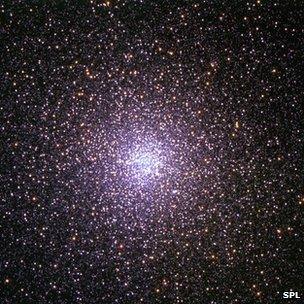Youngest millisecond pulsar shines in gamma rays
- Published

Globular clusters are old collections of hundreds of thousands of stars
The Fermi space telescope has spotted the youngest-ever millisecond pulsar - a fast-spinning cosmic "lighthouse" that is the leftovers from a supernova.
It is the first pulsar from a globular cluster seen to shine in the highest-energy light we know of: gamma rays.
The pulsar's gamma-ray brightness and evident youth challenge our notions of how such millisecond pulsars form.
The paper in Science, external suggests such gamma-ray pulsars may be forming as often as "normal" millisecond pulsars.
Pulsars are what remains after a supernova collapses a burnt-out star to a dense, highly magnetised ball of neutrons - a neutron star.
The star rotates, emitting beams of electromagnetic radiation from its magnetic poles; when those poles point toward our telescopes, we see the lighthouse-like flashes.
Millisecond pulsars are a bit more mysterious; they spin faster than they should if they are formed in the normal way, so it has been assumed that they are old, spent neutron stars that gather up material from a nearby star, spinning them back up to even greater speeds than when they formed - "recycled pulsars".
Most of what we know about pulsars has come from studies in the radio portion of the electromagnetic spectrum.
Instead of radio waves, the Large Area Telescope on Nasa's Fermi satellite is designed to catch the higher-energy radiation known as gamma rays, and in its two years of observations it has spotted dozens of these fastest-spinning pulsars shining in gamma rays, much to the team's surprise.
Now, Fermi has provided another surprise by spotting J1823-3021A, a pulsar that seems to break all the rules.
Cluster luck
The pulsar lies within a globular cluster - a dense field of hundreds of thousands of old stars clinging onto each other through gravity, in what one might call the Galaxy's graveyard.
The cluster is about 27,000 light-years away in the constellation Sagittarius.
Because globular clusters are such messy light sources, and millisecond pulsars tend to be weak, until now it has been impossible to definitively spot a single pulsar within them.
But J1823-3021A was hard to miss in the data, said report co-author Tyrel Johnson, a National Research Council research associate resident at the Naval Research Laboratory in the US.
"Previously some of the radio observations told us that this thing seemed weird, seemed young for a millisecond pulsar, but it could've just been an effect of the cluster itself," he told BBC News.
"But with Fermi, we saw that this thing is just as young and energetic, with just as high a magnetic field as the radio timing suggested."
In fact, that one single pulsar seemed to account for all of the gamma-ray light that Fermi sees; prior estimates based on the amount of gamma rays coming from the cluster suggested as many as 100 individual pulsars might be responsible.
Julie McEnery, Fermi project scientist, called the work "really exciting".
"Most of the ones that we see individually aren't all that bright, so the ones we can see are close by - whereas globular clusters are a lot further away," she told BBC News.
"So a surprise to see a single millisecond pulsar in a globular cluster."
More surprisingly, J1823-3021A seems to be "spinning down" quickly - the pauses between its lighthouse beam growing longer and longer at an unexpected rate.
"This slowdown corresponds to depositing a lot of energy into the environment, that's why it's so bright," explained Dr McEnery. "But that also means that it's going to end very quickly."
That short lifetime in turn means that such gamma-ray millisecond pulsars should be a rare sight for astronomers, a lucky find - unless this strange example is actually the first of a completely different type of pulsar that, until the advent of gamma-ray telescopes, had never been seen.
And that, perhaps counterintuitively, implies that since Fermi has spotted one, they probably form quite commonly.
"The key point is that it has profound implications for our understanding of how millisecond pulsars are formed and behave in globular clusters, and that in turn may have very strong implications of what's actually going on in a globular cluster," Dr McEnery said.
- Published6 October 2011
- Published13 May 2011